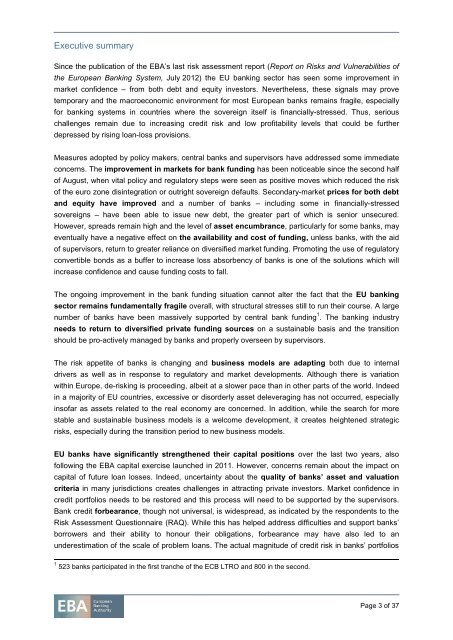EBA Long Report - European Banking Authority - Europa
EBA Long Report - European Banking Authority - Europa
EBA Long Report - European Banking Authority - Europa
You also want an ePaper? Increase the reach of your titles
YUMPU automatically turns print PDFs into web optimized ePapers that Google loves.
Executive summary<br />
Since the publication of the <strong>EBA</strong>’s last risk assessment report (<strong>Report</strong> on Risks and Vulnerabilities of<br />
the <strong>European</strong> <strong>Banking</strong> System, July 2012) the EU banking sector has seen some improvement in<br />
market confidence – from both debt and equity investors. Nevertheless, these signals may prove<br />
temporary and the macroeconomic environment for most <strong>European</strong> banks remains fragile, especially<br />
for banking systems in countries where the sovereign itself is financially-stressed. Thus, serious<br />
challenges remain due to increasing credit risk and low profitability levels that could be further<br />
depressed by rising loan-loss provisions.<br />
Measures adopted by policy makers, central banks and supervisors have addressed some immediate<br />
concerns. The improvement in markets for bank funding has been noticeable since the second half<br />
of August, when vital policy and regulatory steps were seen as positive moves which reduced the risk<br />
of the euro zone disintegration or outright sovereign defaults. Secondary-market prices for both debt<br />
and equity have improved and a number of banks – including some in financially-stressed<br />
sovereigns – have been able to issue new debt, the greater part of which is senior unsecured.<br />
However, spreads remain high and the level of asset encumbrance, particularly for some banks, may<br />
eventually have a negative effect on the availability and cost of funding, unless banks, with the aid<br />
of supervisors, return to greater reliance on diversified market funding. Promoting the use of regulatory<br />
convertible bonds as a buffer to increase loss absorbency of banks is one of the solutions which will<br />
increase confidence and cause funding costs to fall.<br />
The ongoing improvement in the bank funding situation cannot alter the fact that the EU banking<br />
sector remains fundamentally fragile overall, with structural stresses still to run their course. A large<br />
number of banks have been massively supported by central bank funding 1 . The banking industry<br />
needs to return to diversified private funding sources on a sustainable basis and the transition<br />
should be pro-actively managed by banks and properly overseen by supervisors.<br />
The risk appetite of banks is changing and business models are adapting both due to internal<br />
drivers as well as in response to regulatory and market developments. Although there is variation<br />
within Europe, de-risking is proceeding, albeit at a slower pace than in other parts of the world. Indeed<br />
in a majority of EU countries, excessive or disorderly asset deleveraging has not occurred, especially<br />
insofar as assets related to the real economy are concerned. In addition, while the search for more<br />
stable and sustainable business models is a welcome development, it creates heightened strategic<br />
risks, especially during the transition period to new business models.<br />
EU banks have significantly strengthened their capital positions over the last two years, also<br />
following the <strong>EBA</strong> capital exercise launched in 2011. However, concerns remain about the impact on<br />
capital of future loan losses. Indeed, uncertainty about the quality of banks’ asset and valuation<br />
criteria in many jurisdictions creates challenges in attracting private investors. Market confidence in<br />
credit portfolios needs to be restored and this process will need to be supported by the supervisors.<br />
Bank credit forbearance, though not universal, is widespread, as indicated by the respondents to the<br />
Risk Assessment Questionnaire (RAQ). While this has helped address difficulties and support banks’<br />
borrowers and their ability to honour their obligations, forbearance may have also led to an<br />
underestimation of the scale of problem loans. The actual magnitude of credit risk in banks’ portfolios<br />
1 523 banks participated in the first tranche of the ECB LTRO and 800 in the second.<br />
Page 3 of 37
















